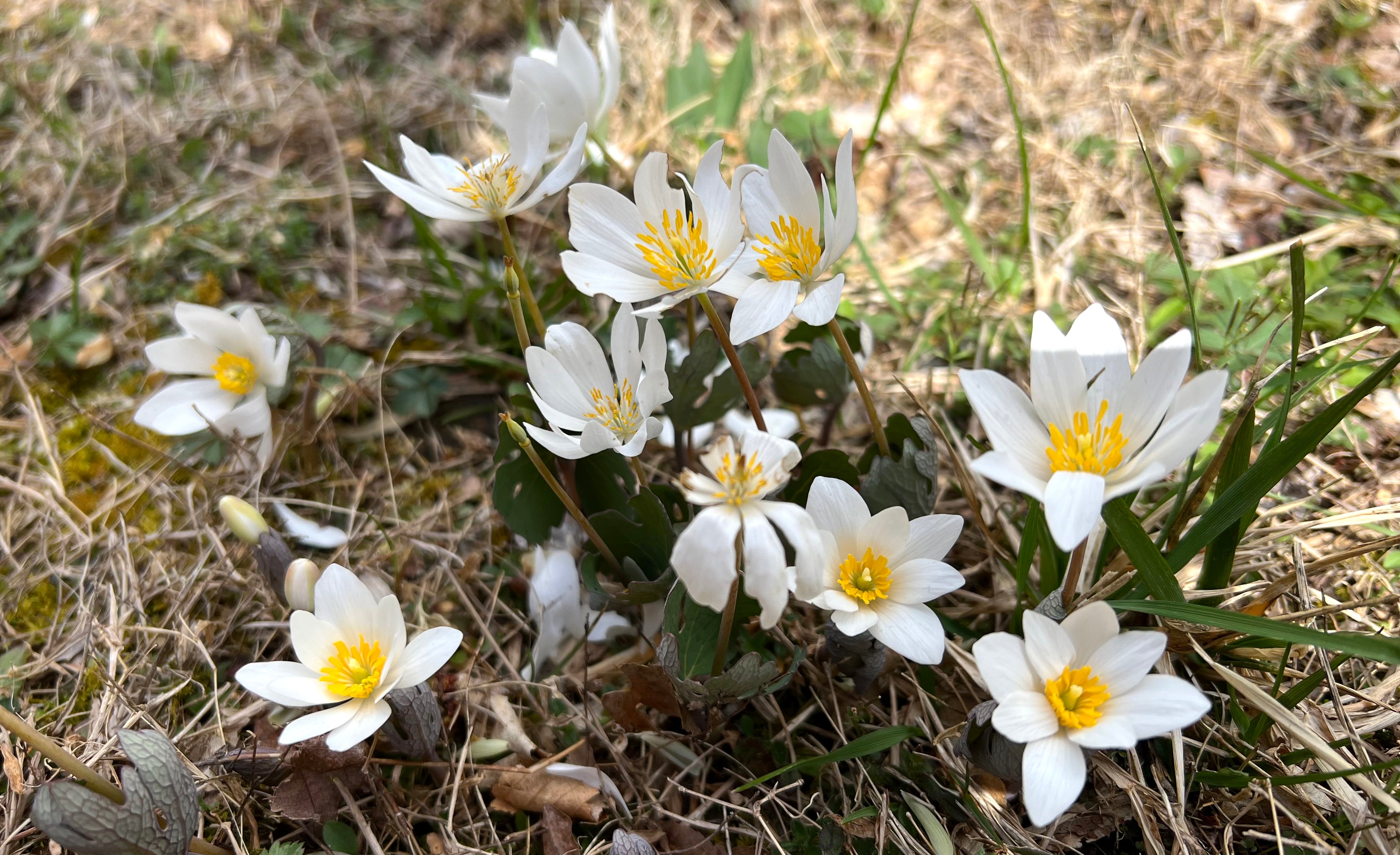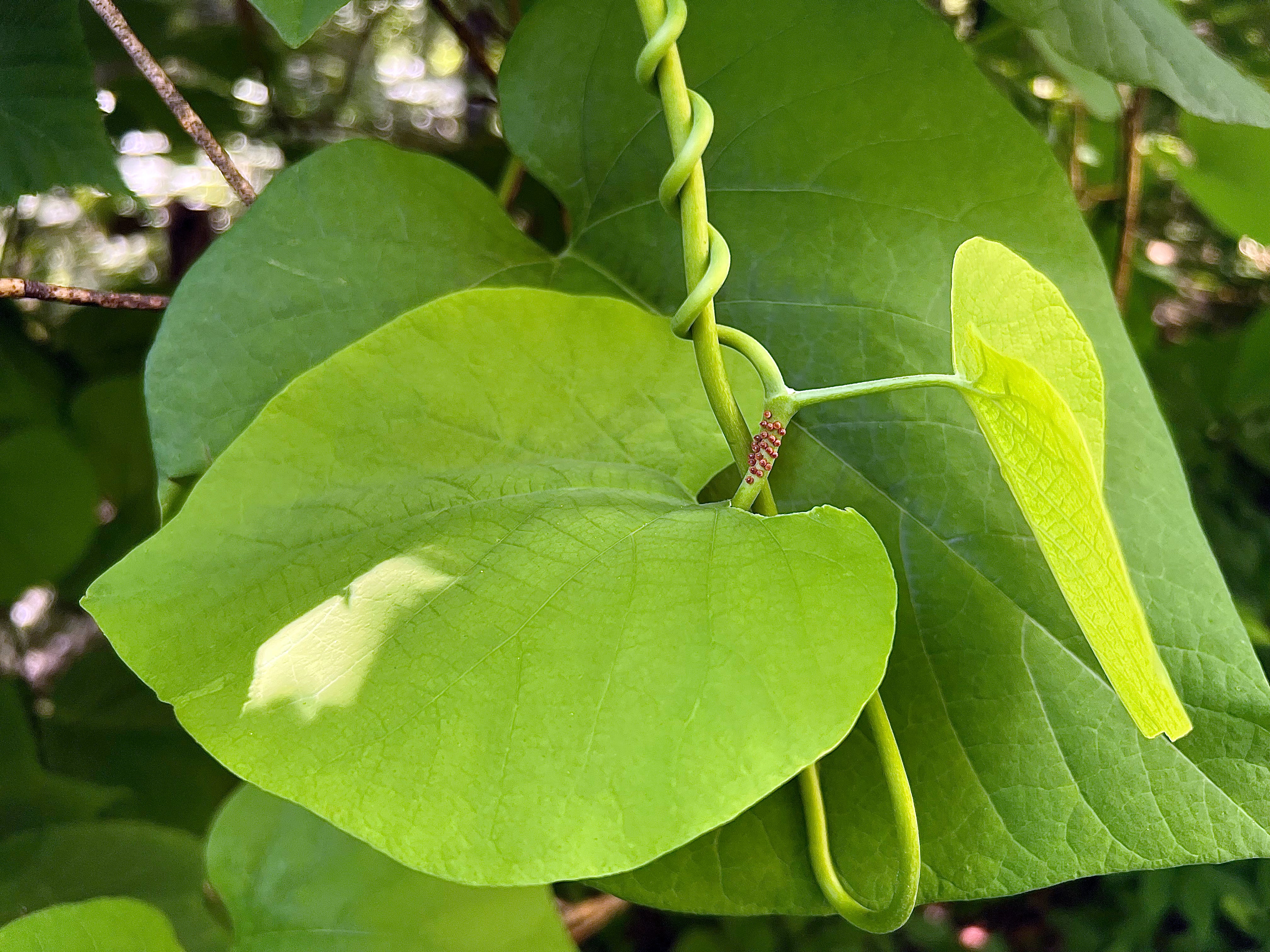
Bloodroot & Honoring Grief
At first glance, Bloodroot is found as just a small white flower. Nothing extraordinary, right? But when you get up close to it, you can take in the magic of this beautifully designed and expressive being. Each plant has one single flower and one single leaf. That’s it. There aren’t many other plants that can claim that description - nature is a lot of things, but simplicity isn’t its specialty. I think of the complexity that took these mountains to be formed, and how each river is ever changing. I think of snowflakes, allegedly, no two alike, and I think about all the things that had to align to allow birds the gift of flight. All the different variations of clouds, beetles, and leaves on a tree. The way the wind makes everything dance, and all the different ways that shadows look when light filters through a tree. And then I look down at tiny Bloodroot and it’s simple consistency.
The first stage is the emergence of a skinny little stem, purple-green in color, with a similarly colored closed bud at the top. This is so easy to overlook. In fact, I have yet to find a new Bloodroot in this stage; I only get to witness this moment with plants I have come back to year after year, already knowing their exact location. Their single leaf doesn’t even give them away, since it appears completely curled around the stem for protection, disguising itself in the process.
The next stage is the unfurling and growth of the flower, slow and methodical, with pauses each night to close back up into a little white teardrop shape. After a lot of work, the flower stands tall and ready, petals outstretched to greet the world. The only pop of color on the plant is thanks to the bright yellow stamens, radiating from the center like the rays of the sun - a welcome offering of connection.

After the flower starts to decline and the petals begin to fall off, the next stage of begins. The protective leaf decides that its job is done, and it is allowed to have its own moment to shine. It slowly leans away from the stem, and over a course of a few days it opens itself like the palm of a hand. What appeared to be a tiny plant turns out to double, triple, sometimes quadruple in size as the energy goes into expanding the leaf. The top side is a vibrant green, and the underside is a milkier color that corresponds with the purplish green stems. And while there is some variation between flowers, I find the most striking differences between the leaves. Some have three lobes, some have nine. Sometimes the lobes are smooth, and other times the lobes appear to have their own tiny lobes. But they all look a crown or halo placed around the delicate stem, and they all look proud to be basking in the sun now, as a reward of a job well done.
While all of this is happening, we must also consider the unseen below the surface. Bloodroot appears methodical and minimal, but inside the soil is a powerful and messy rhizome. The rhizome and roots are reported to be the most concentrated physical medicine of the plant. When used on the human body, it was advised to wait until the flower and leaf were done, both out of respect for the plant’s natural processes and also to wait for the energy to consolidate back in the root, increasing the potency. When the root is cut, magic happens: it secretes a red liquid, basically appearing to bleed. The plant has a lot of important chemical compounds, but it is most notably the isoquinoline alkaloid named sanguinarine that gives the unique red color, which can tone down after processing to make a rich, earthy fiber dye.
Aside from sanguinarine, there are many other alkaloids present in this plant that are being researched in western medicine, in addition to a long history of use from indigenous people and colonizers. It is good at removing things from the body. It has been used as an emetic to induce vomiting, as an expectorant to clear mucus out of the lungs, and topically to remove warts, skin tumors, and even some cancers. Despite the seemingly harsh nature of being an expectorant, it is also good at soothing, as it has been used for coughing, inflammation, and migraines. Although the areas of the body that it can treat will differ depending on who you talk to, the medicinal patterns of removing and soothing reflect the teachings that it offers on a spirit level.
Traditionally used in ancestor work, Bloodroot is known to be wonderful for healing generational wounds. When you meet Bloodroot growing in the wild, you’ll either find it solitary or in small patches. The groups it will grow in are a lot like families, with many plants lengthening the original rhizome to accommodate their own life, reminiscent of adding new branches to a family tree. Their spiritual insight thrives with wounds that have been passed on from parent to child, especially with ones that have repeated that cycle for many generations. This is mirrored in its physical medicine, as one dangerous but noteworthy use of Bloodroot is to eradicate cancers found on the surface of the body. This is a messy, grotesque process that often takes the surrounding tissue with it, getting to the root of the tumor and clearing everything out. What heals afterwards may never look the same, but the tumor would theoretically be gone. With a lot of cancers having a known genetic component in a family line, it is no surprise that Bloodroot’s medicine has been studied here.
But boxing in Bloodroot for only family work is doing it a disservice. Remember that medicinally, it was used to expell things from all different parts of the body. Like a lot of herbal medicine, it works where and how you need it, in attempt to restore balance to your system. It will dissolve whatever you use it on topically, and the same consideration can be applied to it’s spiritual teachings as well. It urges us to look at what we are holding onto that is causing us great harm. It can often be something that has grown slowly, first just an annoyance or concern, but perhaps has developed into something that is impeding your ability to live how you want to. The bleeding of the root is such a stark symbol and reminder to explore the origin of our pain, and not just dwell on the surface of how something feels in the moment.
Moving up from the root, Bloodroot offers us another layer to work with when it comes to the solitary leaf. The leaf starts out its role curled around the stem, forming a protective layer for the vulnerable part of the plant that is trying to grow tall and allow the flower to reach the sunlight. It remains coiled even while becoming vulnerable itself, with the more delicate underside of the leaf actually forming the outer layer of protection. It can prompt us to look at our wounds in a layered way: what is the source of the wound, and how have you adapted yourself to guard it? What have the elements done to you when your vulnerable parts were exposed?

When the flower is finished and has gone to seed, Bloodroot’s leaves finally stretch out, opening and expanding to reveal a beautiful variety of shapes and patterns, each one unique. After they have opened up, they continue to grow in size. I would argue that the leaves are perhaps even more beautiful than the flower, especially given the symbolism. They have entered into the world with a job to do, and once the job is finished, they are able to present themselves to the world and enjoy being a part of the bigger picture. I see this moment as a celebration. I see this as the leaf of the plant coming into its own, standing tall and proud. When I witness this time in the plant’s life, it prompts me to look at my own wounds, my own grief, the heaviness I have been carrying, and to try to find the celebration in it all.
It is common in our culture to shy away from grief, even though it is a healthy and necessary part of being a human. Suppressing our feelings is a skill many of us learned in childhood and have carried into being an adult. An important offering from Bloodroot is that not only is it necessary to let it all come to the surface, not only must we learn how to feel our pain, but we can look at grief as a gift and even learn how to honor it. The way we grieve reflects the way we love. It illuminates our values and it illustrates how deep something has touched us.
“If grief is a way of loving that which is slipped from view, then it must stand that love is a way of grieving.” Stephen Jenkinson
A misconception given to us by our culture is that when you have grieved what you need to, you can move on. But it isn’t about getting over something. Grief is an adaptation and a knowing that things will never be as they were. It is a continuous cycle that we eventually learn how to tend to. It is deep sorrow, yes - but it is also a chance to give thanks to what we have been fortunate enough to experience. It is sacred and we all need to practice treating it as such, even if honoring it just means being present with the grief.
It can be hard to move through the cycles of grief, as if moving through our pain would invalidate the existence of what we loved, what we knew, or what we never received from someone. This is where being with Bloodroot can help. This is where you have to trust the process and move through the phases to see what becomes. This is where your leaf unfurls and learns to take in the sun, growing with each day until you reach a size you didn’t know possible. This is where the tiny leaf that clung to the stem becomes a beautiful, expansive crown.

Disclaimer: This article is about working with the energetics of this plant and does not encourage ingesting the actual plant.



